Effect of Local Winds on Salinity Intrusion in the Columbia River Estuary
Abstract
:1. Introduction
2. Materials and Methods
2.1. Site Description
2.2. The Model and the Simulations
2.3. Observations
2.3.1. Monitoring Stations
2.3.2. Wind Forcing and River Discharge
2.4. Salinity Intrusion Analysis
2.5. Mixing and Froude Number
3. Results
3.1. Effects of the Resolution of Atmospheric Forcing
3.2. Salinity Intrusion
3.3. Events of Westerly/Easterly Winds
4. Discussion
5. Summary and Conclusions
Author Contributions
Funding
Data Availability Statement
Acknowledgments
Conflicts of Interest
Appendix A
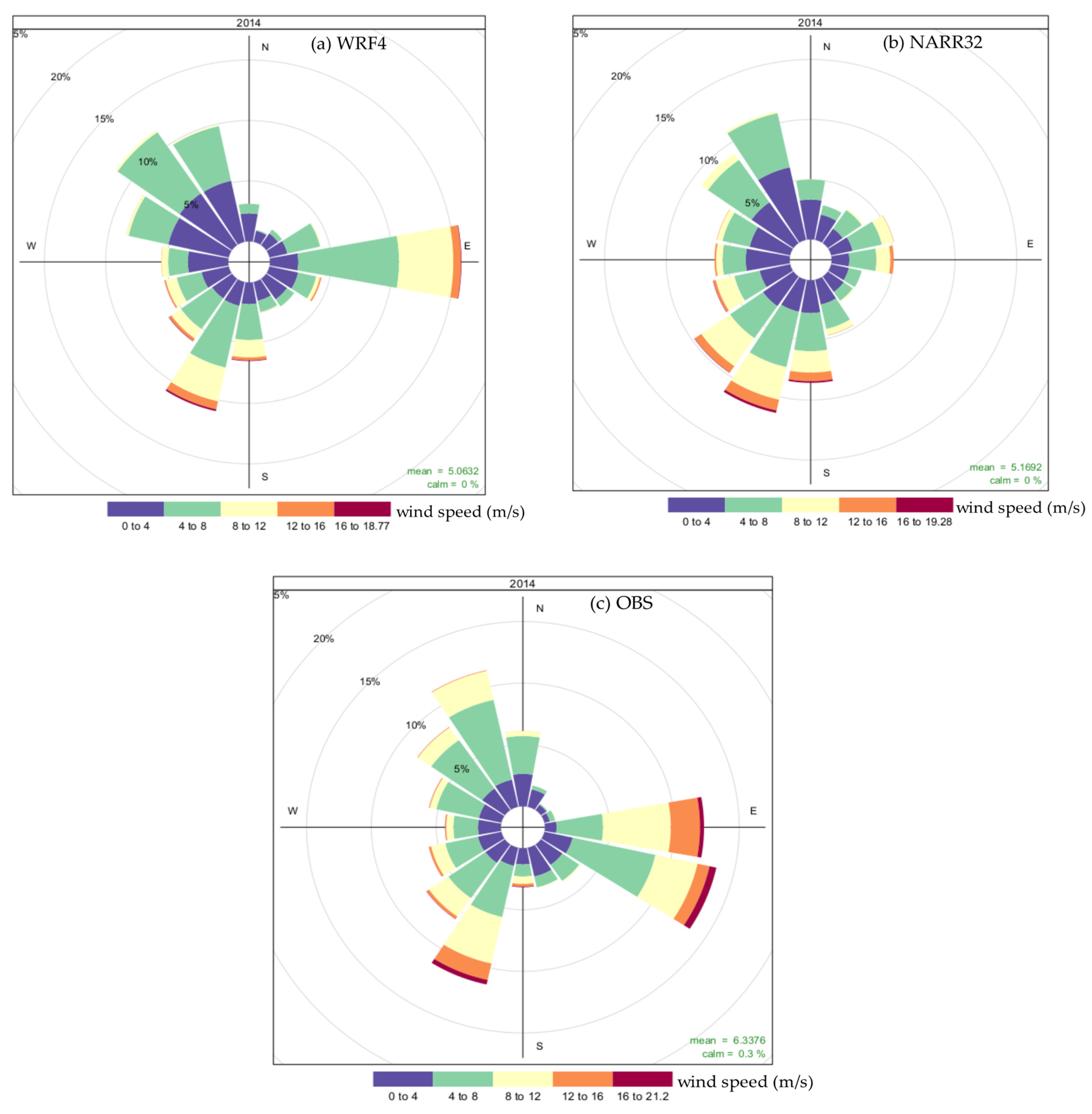
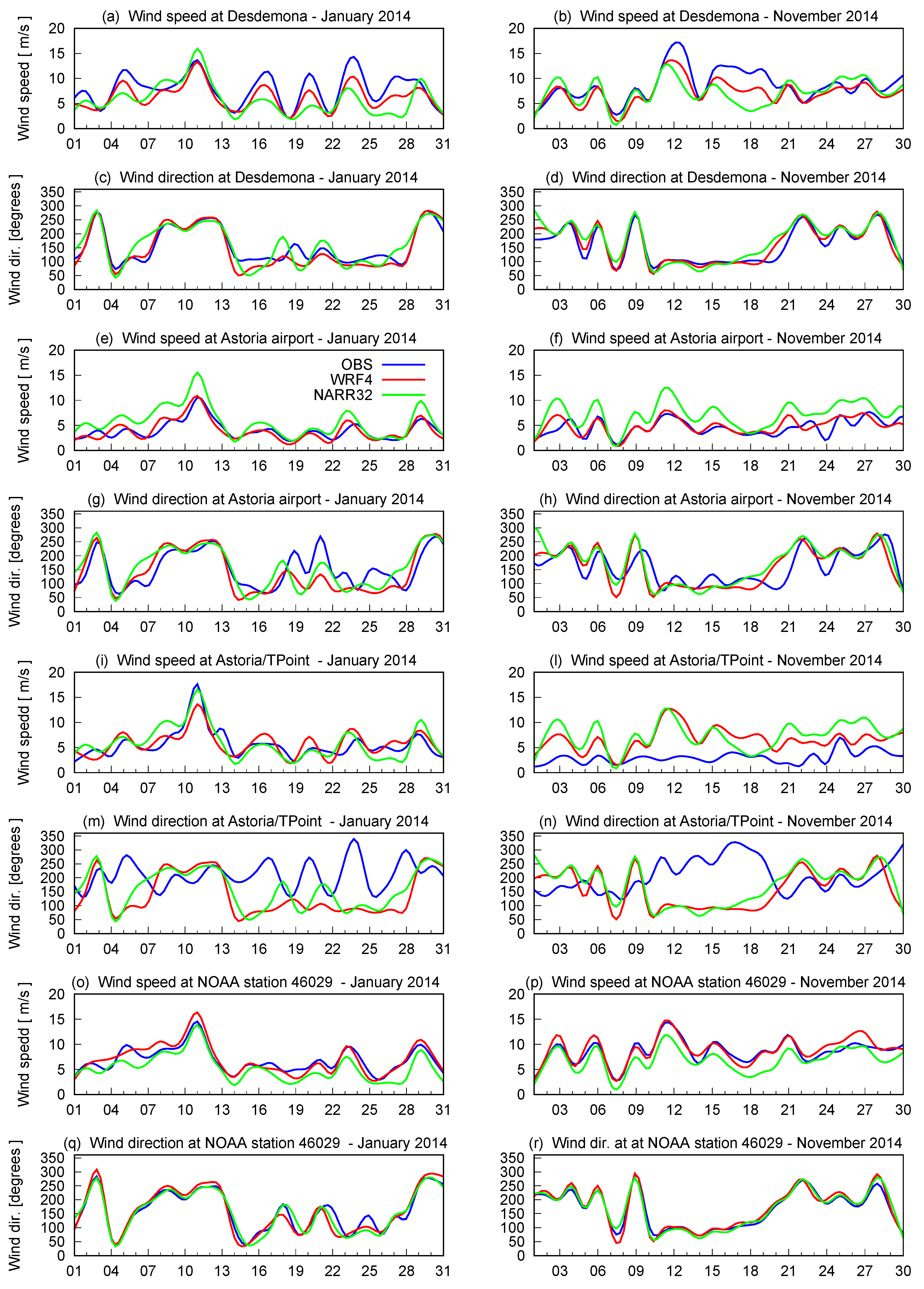
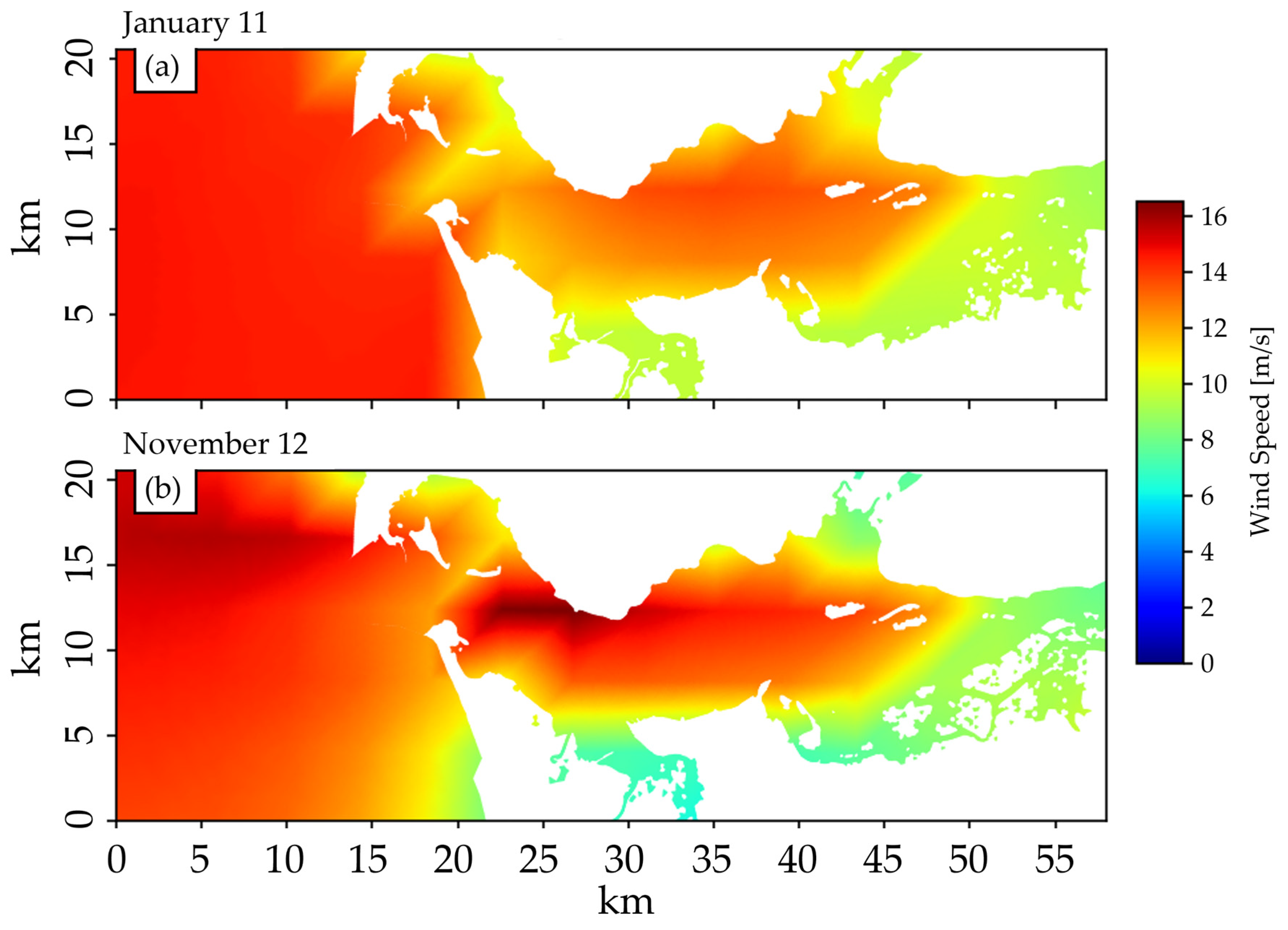
References
- North, E.W.; Chao, S.Y.; Sanford, L.P.; Hood, R.R. The influence of wind and river pulses on an estuarine turbidity maximum: Numerical studies and field observations in Chesapeake Bay. Estuaries 2004, 27, 132–146. [Google Scholar] [CrossRef]
- Cloern, J.E.; Jassby, A.D.; Schraga, T.S.; Nejad, E.; Martin, C. Ecosystem variability along the estuarine salinity gradient: Examples from long-term study of San Francisco Bay. Limnol. Oceanogr. 2017, 62, S272–S291. [Google Scholar] [CrossRef] [Green Version]
- Gillanders, B.M.; Kingsford, M.J. Impact of changes in flow of freshwater on estuarine and open coastal habitats and the associated organisms. In Oceanography and Marine Biology: An Annual Review; Gibson, R.N., Barnes, M., Atkinson, R.J.A., Eds.; Taylor & Francis: Abingdon, UK, 2002; Volume 40, pp. 233–309. [Google Scholar]
- Tian, R. Factors controlling saltwater intrusion across multi-time scales in estuaries, Chester River, Chesapeake Bay. Estuarine Coast. Shelf Sci. 2019, 223, 61–73. [Google Scholar] [CrossRef]
- Dijkstra, Y.M.; Schuttelaars, H.M. A Unifying Approach to Subtidal Salt Intrusion Modeling in Tidal Estuaries. J. Phys. Oceanogr. 2021, 51, 147–167. [Google Scholar] [CrossRef]
- Bellafiore, D.; Ferrarin, C.; Maicu, F.; Manfè, G.; Lorenzetti, G.; Umgiesser, G.; Zaggia, L.; Levinson, A.V. Saltwater Intrusion in a Mediterranean Delta Under a Changing Climate. J. Geophys. Res. Oceans 2021, 126, 1–23. [Google Scholar] [CrossRef]
- Reyes-Merlo, M.Á.; Díez-Minguito, M.; Ortega-Sánchez, M.; Baquerizo, A.; Losada, M.Á. On the relative influence of climate forcing agents on the saline intrusion in a well-mixed estuary: Medium-term Monte Carlo predictions. J. Coast. Res. 2013, 165, 1200–1205. [Google Scholar] [CrossRef]
- Gong, W.; Lin, Z.; Chen, Y.; Chen, Z.; Zhang, H. Effect of winds and waves on salt intrusion in the Pearl River estuary. Ocean Sci. 2018, 14, 139–159. [Google Scholar] [CrossRef] [Green Version]
- Zhou, W.; Wang, D.; Luo, L. Investigation of saltwater intrusion and salinity stratification in winter of 2007/2008 in the Zhujiang River Estuary in China. Acta Oceanol. Sin. 2012, 31, 31–46. [Google Scholar] [CrossRef]
- Zhang, E.; Gao, S.; Savenije, H.H.; Si, C.; Cao, S. Saline water intrusion in relation to strong winds during winter cold outbreaks: North Branch of the Yangtze Estuary. J. Hydrol. 2019, 574, 1099–1109. [Google Scholar] [CrossRef]
- Jongbloed, H.; Schuttelaars, H.M.; Dijkstra, Y.M.; Donkers, P.B.; Hoitink, A.J.F. Influence of Wind on Subtidal Salt Intrusion and Stratification in Well-Mixed and Partially Stratified Estuaries. J. Phys. Oceanogr. 2022, 52, 3139–3158. [Google Scholar] [CrossRef]
- Reyes-Hernández, C.; Valle-Levinson, A. Wind Modifications to Density-Driven Flows in Semienclosed, Rotating Basins. J. Phys. Oceanogr. 2010, 40, 1473–1487. [Google Scholar] [CrossRef]
- Jia, P.; Li, M. Dynamics of wind-driven circulation in a shallow lagoon with strong horizontal density gradient. J. Geophys. Res. 2012, 117, C05013. [Google Scholar] [CrossRef]
- Kim, C.-K.; Park, K. A modeling study of water and salt exchange for a micro-tidal, stratified northern Gulf of Mexico estuary. J. Mar. Syst. 2012, 96-97, 103–115. [Google Scholar] [CrossRef]
- Li, Y.; Li, M. Wind-driven lateral circulation in a stratified estuary and its effects on the along-channel flow. J. Geophys. Res. 2012, 117, C09005. [Google Scholar] [CrossRef] [Green Version]
- Li, Y.; Li, M. Effects of winds on stratification and circulation in a partially mixed estuary. J. Geophys. Res. 2011, 116, C12012. [Google Scholar] [CrossRef]
- Geyer, W. Influence of Wind on Dynamics and Flushing of Shallow Estuaries. Estuar. Coast. Shelf Sci. 1997, 44, 713–722. [Google Scholar] [CrossRef]
- Wang, D.-P. Wind-Driven Circulation in the Chesapeake Bay, Winter, 1975. J. Phys. Oceanogr. 1979, 9, 564–572. [Google Scholar] [CrossRef]
- Scully, M.E.; Friedrichs, C.; Brubaker, J. Control of estuarine stratification and mixing by wind-induced straining of the estuarine density field. Estuaries 2005, 28, 321–326. [Google Scholar] [CrossRef]
- Jay, D.A. Circulatory Processes in the Columbia River Estuary; Columbia River Estuary Data Development Program: Astoria, OR, USA, 1984; 169p. [Google Scholar]
- Jay, D.A.; Smith, J.D. Circulation, density structure and neap-spring transitions in the Columbia River Estuary. Prog. Oceanogr. 1990, 25, 81–112. [Google Scholar] [CrossRef]
- Baptista, A.M.; Zhang, Y.L.; Chawla, A.; Zulauf, M.; Seaton, C.; Myers, E.P., III; Kindle, J.; Wilkin, M.; Burla, M.; Turner, P.J. A cross-scale model for 3D baroclinic circulation in estuary-plume-shelf systems: II. Application to the Columbia River. Cont. Shelf Res. 2005, 25, 935–972. [Google Scholar] [CrossRef]
- Liu, Y.; MacCready, P.; Hickey, B.M.; Dever, E.P.; Kosro, P.M.; Banas, N.S. Evaluation of a coastal ocean circulation model for the Columbia River plume in summer 2004. J. Geophys. Res. Oceans 2009, 114, 1–23. [Google Scholar] [CrossRef] [Green Version]
- Elias, E.P.L.; Gelfenbaum, G.; Van der Westhuysen, A.J. Validation of a coupled wave-flow model in a high-energy setting: The mouth of the Columbia River. J. Geophys. Res. Oceans 2012, 117, C09011. [Google Scholar] [CrossRef]
- Jay, D.A.; Leffler, K.; Diefenderfer, H.L.; Borde, A.B. Tidal-Fluvial and Estuarine Processes in the Lower Columbia River: I. Along-Channel Water Level Variations, Pacific Ocean to Bonneville Dam. Estuaries Coasts 2014, 38, 415–433. [Google Scholar] [CrossRef]
- Helaire, L.T.; Talke, S.A.; Jay, D.A.; Mahedy, D. Historical Changes in Lower Columbia River and Estuary Floods: A Numerical Study. J. Geophys. Res. Oceans 2019, 124, 7926–7946. [Google Scholar] [CrossRef]
- Chawla, A.; Jay, D.A.; Baptista, A.; Wilkin, M.; Seaton, C. Seasonal Variability and Estuary–Shelf Interactions in Circulation Dynamics of a River-dominated Estuary. Estuaries Coasts 2008, 31, 269–288. [Google Scholar] [CrossRef] [Green Version]
- MacCready, P.; Banas, N.; Hickey, B.M.; Dever, E.P.; Liu, Y. A model study of tide- and wind-induced mixing in the Columbia River Estuary and plume. Cont. Shelf Res. 2009, 29, 278–291. [Google Scholar] [CrossRef]
- Burla, M.; Baptista, A.M.; Zhang, Y.; Frolov, S. Seasonal and interannual variability of the Columbia River plume: A perspective enabled by multiyear simulation databases. J. Geophys. Res. Oceans 2010, 115, C00B16. [Google Scholar] [CrossRef]
- Giddings, S.N.; MacCready, P. Reverse Estuarine Circulation Due to Local and Remote Wind Forcing, Enhanced by the Presence of Along-Coast Estuaries. J. Geophys. Res. Oceans 2017, 122, 10184–10205. [Google Scholar] [CrossRef] [Green Version]
- Zhang, Y.; Baptista, A.M. SELFE: A semi-implicit Eulerian–Lagrangian finite-element model for cross-scale ocean circulation. Ocean Model. 2008, 21, 71–96. [Google Scholar] [CrossRef]
- Kärnä, T.; Baptista, A.M.; Lopez, J.E.; Turner, P.J.; McNeil, C.; Sanford, T.B. Numerical modeling of circulation in high-energy estuaries: A Columbia River estuary benchmark. Ocean Model. 2015, 88, 54–71. [Google Scholar] [CrossRef]
- Kärnä, T.; Baptista, A. Evaluation of a long-term hindcast simulation for the Columbia River estuary. Ocean Model. 2016, 99, 1–14. [Google Scholar] [CrossRef] [Green Version]
- Kukulka, T.; Jay, D.A. Impacts of Columbia River discharge on salmonid habitat: 1. A nonstationary fluvial tide model. J. Geophys. Res. Oceans 2003, 108, 3293. [Google Scholar] [CrossRef] [Green Version]
- Naik, P.K.; Jay, D.A. Distinguishing human and climate influences on the Columbia River: Changes in mean flow and sediment transport. J. Hydrol. 2011, 404, 259–277. [Google Scholar] [CrossRef]
- Jay, D.A.; Smith, J.D. Residual circulation in shallow estuaries: 1. Highly stratified, narrow estuaries. J. Geophys. Res. 1990, 95, 711–731. [Google Scholar] [CrossRef] [Green Version]
- Hickey, B.M.; Banas, N. Oceanography of the U.S. Pacific Northwest Coastal Ocean and estuaries with application to coastal ecology. Estuaries 2003, 26, 1010–1031. [Google Scholar] [CrossRef]
- Hickey, B.; Geier, S.; Kachel, N.; MacFadyen, A. A bi-directional river plume: The Columbia in summer. Cont. Shelf Res. 2005, 25, 1631–1656. [Google Scholar] [CrossRef]
- WRCC (Western Regional Climate Center) Period of Record Monthly Climate Summary, Astoria, Oregon (350324). 2009. Available online: http://www.wrcc.dri.edu/cgi-bin/cliMAIN.pl?or0324 (accessed on 28 November 2022).
- Mass, C.; Dotson, B. Major Extratropical Cyclones of the Northwest United States: Historical Review, Climatology, and Synoptic Environment. Mon. Weather. Rev. 2010, 138, 2499–2527. [Google Scholar] [CrossRef]
- Mesinger, F.; Di Mego, G.; Kalnay, E.; Mitchell, K.; Shafran, P.C.; Ebisuzaki, W.; Jović, D.; Woollen, J.; Rogers, E.; Berbery, E.H.; et al. North American Regional Reanalysis. Bull. Am. Meteorol. Soc. 2006, 87, 343–360. [Google Scholar] [CrossRef] [Green Version]
- Bleck, R. An oceanic general circulation model framed in hybrid isopycnic-Cartesian coordinates. Ocean Model. 2002, 4, 55–88. [Google Scholar] [CrossRef]
- Baptista, A.M.; Seaton, C.; Wilkin, M.P.; Riseman, S.F.; Needoba, J.A.; Maier, D.; Turner, P.J.; Kärnä, T.; Lopez, J.E.; Herfort, L.; et al. Infrastructure for collaborative science and societal applications in the Columbia River estuary. Front. Earth Sci. 2015, 9, 659–682. [Google Scholar] [CrossRef]
- Michalakes, J.; Dudhia, J.; Gill, D.; Henderson, T.; Klemp, J.; Skamarock, W.; Wang, W. The Weather Research and Forecast Model: Software Architecture and Performance. In Proceedings of the Eleventh ECMWF Workshop on the Use of High Performance Computing in Meteorology, Reading, UK, 25–29 October 2004; Zwieflhofer, W., Mozdzynski, G., Eds.; World Scientific: Singapore, 2005; pp. 156–168. [Google Scholar]
- Brewer, M.C.; Mass, C.F. Simulation of Summer Diurnal Circulations over the Northwest United States. Weather. Forecast. 2014, 29, 1208–1228. [Google Scholar] [CrossRef]
- Baptista, A.M.; Wilkin, M.; Pearson, P.; Turner, P.; McCandlish, C.; Barrett, P. Coastal and estuarine forecast systems—A multi-purpose infrastructure for the Columbia River. Earth Syst. Monit. 1999, 9, 1–2+4. [Google Scholar]
- Baptista, A.M. CORIE: The first decade of a coastal-margin collaborative observatory. In Proceedings of the Oceans’06 MTS/IEEE, Boston, MA, USA, 18–21 September 2006. [Google Scholar]
- Monismith, S.G.; Kimmerer, W.; Burau, J.R.; Stacey, M.T. Structure and Flow-Induced Variability of the Subtidal Salinity Field in Northern San Francisco Bay. J. Phys. Oceanogr. 2002, 32, 3003–3019. [Google Scholar] [CrossRef]
- Bowen, M.M. Salt transport and the time-dependent salt balance of a partially stratified estuary. J. Geophys. Res. Atmos. 2003, 108, C5. [Google Scholar] [CrossRef]
- Ralston, D.K.; Geyer, W.R.; Lerczak, J.A. Subtidal Salinity and Velocity in the Hudson River Estuary: Observations and Modeling. J. Phys. Oceanogr. 2008, 38, 753–770. [Google Scholar] [CrossRef] [Green Version]
- Geyer, W.R.; MacCready, P. The Estuarine Circulation. Annu. Rev. Fluid Mech. 2014, 46, 175–197. [Google Scholar] [CrossRef]
- Geyer, W.R. Estuarine salinity structure and circulation. In Contemporary Issues in Estuarine Physics; Valle-Levinson, A., Ed.; Cambridge University Press: Cambridge, UK, 2010; Chapter 2; pp. 12–26. [Google Scholar]
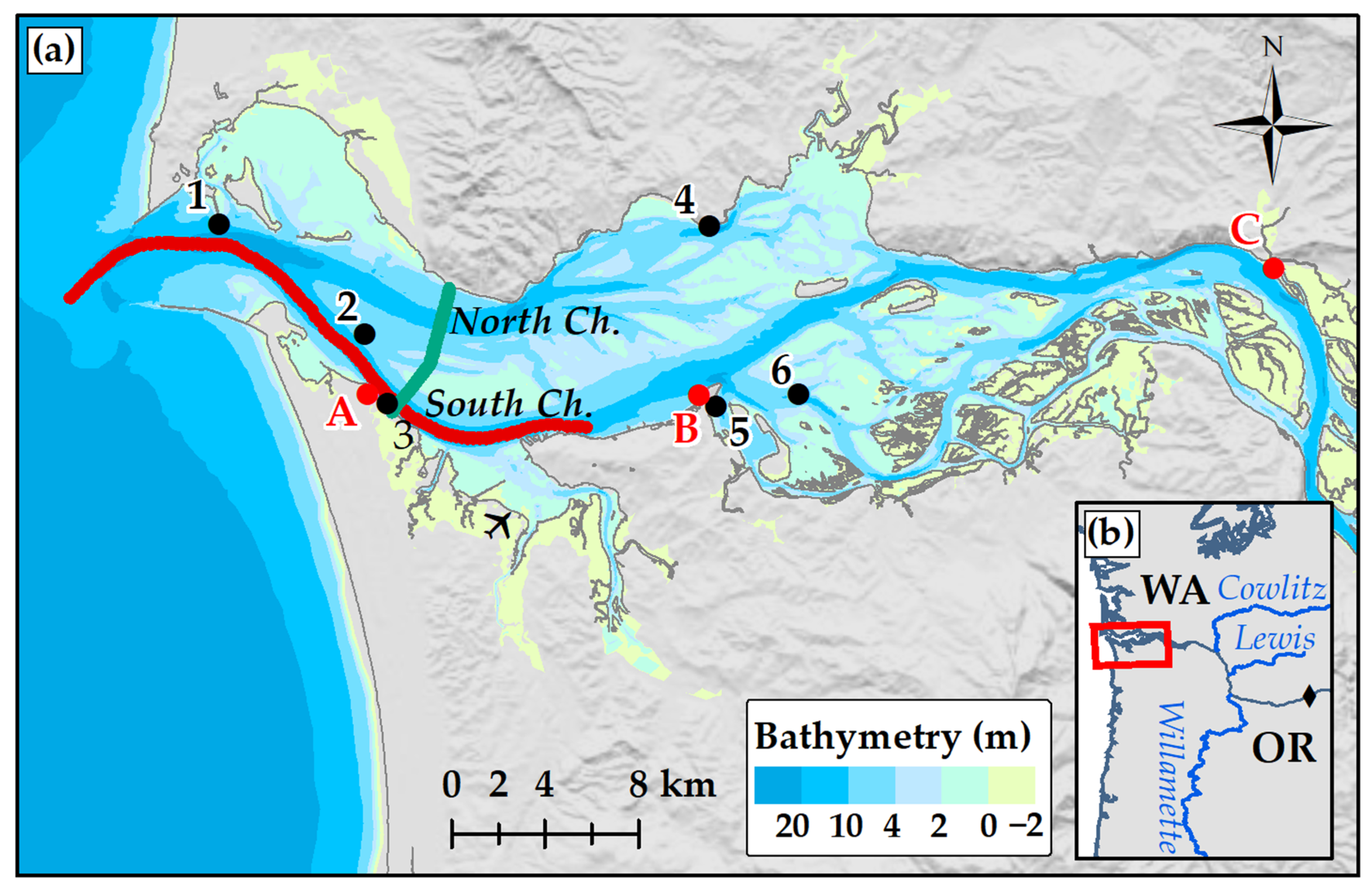





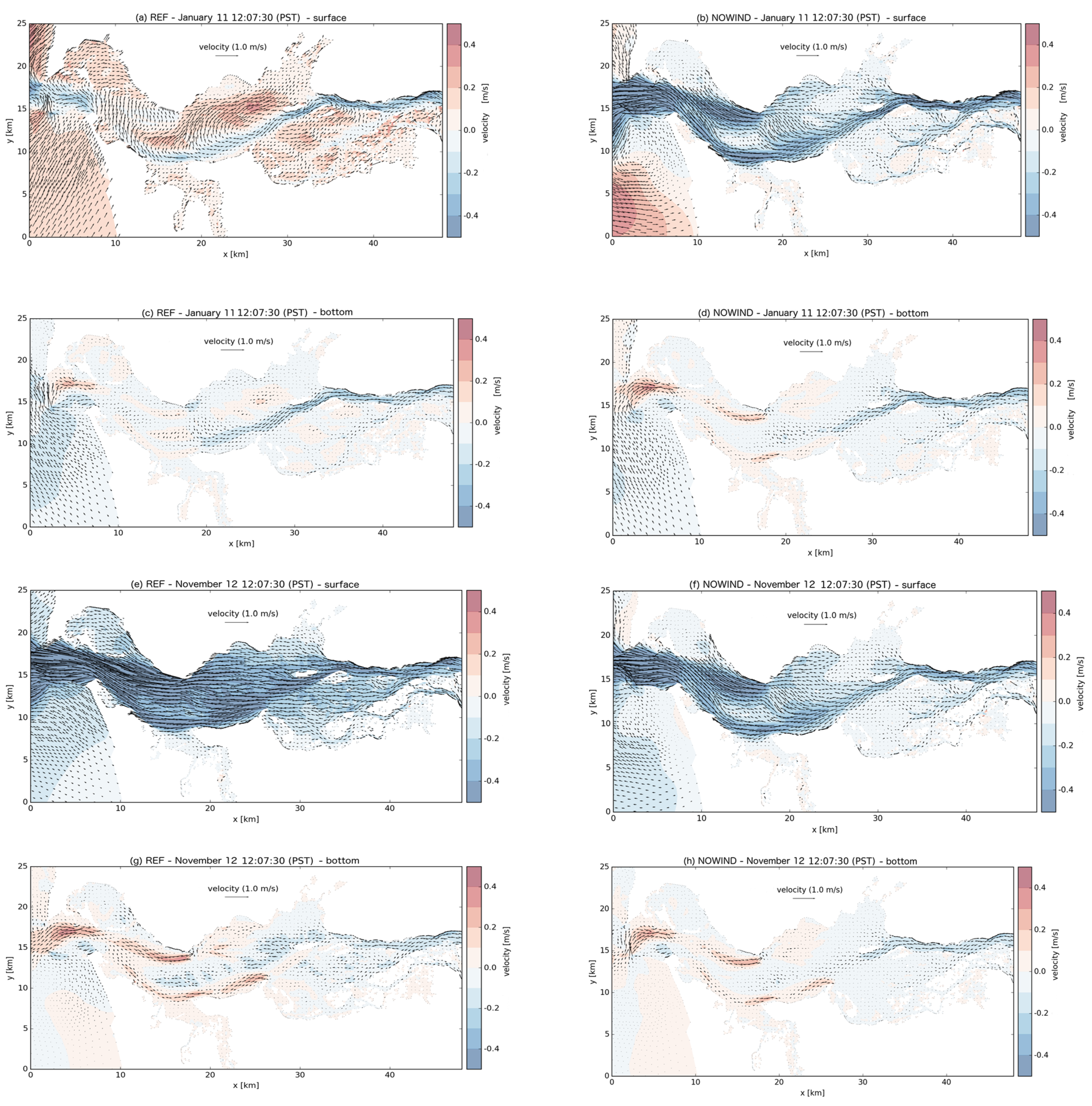

| Simulation | Description |
|---|---|
| REF | High resolution atm. forcing from WRF4 (4 km) in both shelf and estuary (reference) |
| NOWIND | High resolution atm. forcing from WRF4 (4 km) in the shelf and no wind in the estuary |
| NARR | Low-medium atm. forcing from NARR32 (32 km) in both shelf and estuary |
| SIL vs. Discharge | Full Year | Winter | Other |
|---|---|---|---|
| REF | −0.8030 | −0.2382 | −0.9107 |
| NOWIND | −0.8326 | −0.3217 | −0.9092 |
| NARR | −0.8117 | −0.2636 | −0.9052 |
Disclaimer/Publisher’s Note: The statements, opinions and data contained in all publications are solely those of the individual author(s) and contributor(s) and not of MDPI and/or the editor(s). MDPI and/or the editor(s) disclaim responsibility for any injury to people or property resulting from any ideas, methods, instructions or products referred to in the content. |
© 2023 by the authors. Licensee MDPI, Basel, Switzerland. This article is an open access article distributed under the terms and conditions of the Creative Commons Attribution (CC BY) license (https://creativecommons.org/licenses/by/4.0/).
Share and Cite
Scroccaro, I.; Spitz, Y.H.; Seaton, C.M. Effect of Local Winds on Salinity Intrusion in the Columbia River Estuary. Water 2023, 15, 326. https://doi.org/10.3390/w15020326
Scroccaro I, Spitz YH, Seaton CM. Effect of Local Winds on Salinity Intrusion in the Columbia River Estuary. Water. 2023; 15(2):326. https://doi.org/10.3390/w15020326
Chicago/Turabian StyleScroccaro, Isabella, Yvette H. Spitz, and Charles M. Seaton. 2023. "Effect of Local Winds on Salinity Intrusion in the Columbia River Estuary" Water 15, no. 2: 326. https://doi.org/10.3390/w15020326





